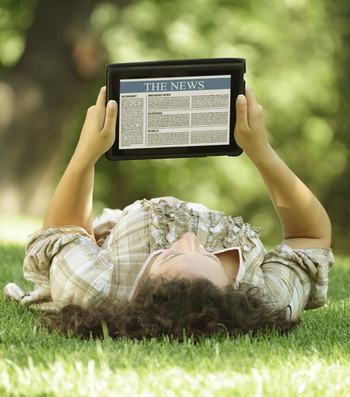Approximately 3.22 million people in the United States have a visual impairment.
For people with a visual impairment, reading is often one of the most difficult challenges. Many people with low stop reading altogether, because what used to be an effortless and enjoyable activity now requires preparation and a lot of adjustment.
There are many low vision devices that can make reading easier and more rewarding for people with macular degeneration, retinitis pigmentosa, tunnel vision and other low vision conditions.
If you experience low vision, contact an eye doctor near you who can prescribe a low vision device to help you read without difficulty.
SEE RELATED: Top 10 Tips for Improving Low Vision at Home
Below you will find a list of low vision magnifiers, aids, devices, and strategies that can help people with low vision read more easily and comfortably.
Low Vision Devices for Reading
1. Reading Magnifier
The most commonly used visual aid is a hand-held magnifier, for reading.
In the correct power, magnifiers allow people with low vision to reading labels, oven dials, and the text on medicine bottles. There are different kinds of magnifiers, including small pocket magnifiers, full-page illuminated magnifiers, and magnifiers that are mounted on adjustable stands.
Ask your low vision optometrist which device and power will best allow you to read what is most important for you.
2. Video Magnifier
While traditional optical magnifiers, such as magnifying glasses, are generally helpful, some people benefit more from a video magnifier.
A video magnifier, or closed-circuit television (CCTV), has a camera that transmits magnified images (up to 50x or higher) and displays them on a large monitor or TV screen.
3. Portable Electronic Magnifiers
A portable electronic magnifier resembles an iPad or tablet. By holding this device in front of reading material, you can view the magnified version on its LED screen.
4. High-Power Reading Glasses
Strong magnifying reading eyeglasses enable a person with severe visual impairment to read fine print.
5. Tele-Microscopic Glasses
Tele-microscopic lenses are mounted on top of eyeglass lenses and may be prescribed for one or both eyes. They allow people with low vision to read, write, use a computer, and perform other tasks at a comfortable distance.
Certain low vision devices require a prescription from an eye doctor as they are custom-made for a patients specific needs.
Contact an eye doctor near you, who will help determine which vision devices and aids are best for your needs and level of vision impairment.
More strategies to help your reading
1. Increase Contrast
It’s important to ensure a sharp contrast between the text being read and its background.
For example, newspapers don’t offer much contrast because the grey letters sit on an off-white background.
Many electronic screens allow a person to tailor the contrast to their needs, such as black lettering on a white background or black lettering on a yellow background.
2. Increase Lighting
Increasing the amount and type of lighting can greatly improve reading ability in those with low vision.
3. Large Print Books or Larger Fonts
Large print books include larger fonts, more spacing and better contrast, making it easier and more enjoyable to read.
4. Adjust Settings on your smart phone
Smart phones have various settings specifically designed for low vision. These range from large fonts to read-aloud SMS messaging.
LEARN MORE: Guide to Low Vision
Schedule an appointment with an eye doctor near you for more advice on reading with low vision and to learn about what low vision aids and devices would be best for you.


